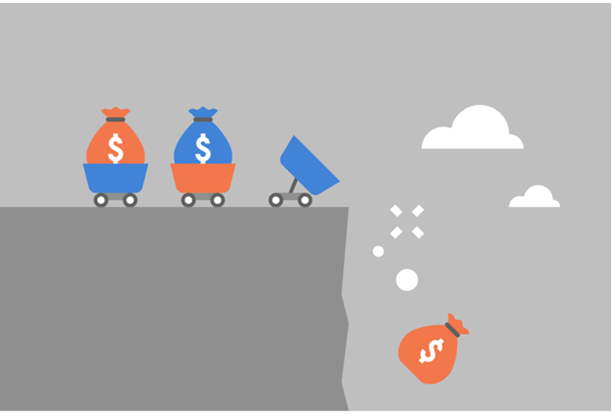What do you mean by wasting assets?
An asset whose value keeps depreciating over its fixed useful life is classified as a wasting asset. Such assets can be very easily encountered in daily life, for example, oil and petroleum. Wasting assets have a fixed nature and get depleted or consumed gradually with time and use. Therefore, the rate at which such wastage is considered while valuing the asset or forecasting revenue generation from it is worth pondering.
Highlights
- A wasting asset is an asset class whose value declines with time, and it becomes inexistent after its fixed life span is over.
- The most relatable example of a wasting asset is petroleum or a metal mine; the value assigned to the mine keeps depleting as the metal extraction goes on, and then it becomes devoid of the metal.
- Wasting assets are irreplaceable and are fully consumed over their life.
Frequently Asked Questions (FAQ)-
How is a wasting asset different from a fixed asset?

Source: © Tugores34 | Megapixl.com
Fixed assets differ from wasting assets because fixed assets are replaceable. They can be replaced with the same kind of asset providing the same output. Whereas wasting assets like mines and oil rigs are irreplaceable. Once used, there is no other existing asset that can give the same output.
Also, in the case of fixed assets, the value of assets decreases due to normal wear and tear, but a wasting asset’s value is lost with time and use due to obsolescence. Therefore, the decline is gradual but results in exhaustion or reducing stock.
What are the features of a wasting asset?
Wasting Assets can be identified by the following feature-
- Wasting Assets have a fixed useful life.
- The value of a wasting asset goes down as the time of its useful life gets passed.
- Wasting assets depreciate in a manner that their residual value/scrap value is not even equal to the value of one part.
- Wasting Assets may sometimes be called consumed assets.
What are the examples of wasting assets?
A few common examples of wasting assets are-
- Vehicles; trucks, busses, dumpers, etc.
- Machinery; drilling machines, processing equipment, etc.
- Natural resources like oil, petroleum, etc.
- Mines like coal mines, gold mines, copper mines and others.
- Oil Drilling and exploration rigs, etc.
What are the benefits of wasting assets?
- Ownership costs are lower than leasing costs. Thus, businesses prefer to own wasting assets.
- Tax exemptions and savings are allowed on the depreciation charged against such wasting assets.
- Advantages can be obtained by the company as and when required.
- It can turn out to be a tremendous source of income if it is used efficiently and effectively.
- Wasting assets in financial instruments is one of the smartest ways to invest as there is arbitrary gain at the initial time of investment from the asset.
- It pays 100% ROIif the exact useful life is determined and it is used properly.
- Wasting asset types of financial instruments are a low-risk option as they expire after decay.
Why is it bad to hold wasting assets?

Source: © Stmool | Megapixl.com
- As wasting assets generally are costly, a huge amount of capital is needed to buy them.
- Wasting assets like mines and oil rigs have high maintenance costs, increasing as it nears the end of useful life.
- There is no or minimal residual value a business can obtain from wasting assets.
- The value assigned to wasting assets keeps on decreasing with time; hence a regular revision of its actual value is needed.
- Investors cannot use wasting assets kind of financial instruments for long term investment purposes.
- More often, it is seen that they are not managed well, and benefits compared to costs are very low.
- Some wasting assets disappear or remain no more available, like petroleum. There is no salvage or residual value that the company can obtain.
- If such assets are purchased without proper understanding, they may result in huge losses, becoming unbearable.
- A lot of provisioning may be required following conservatism to protect from losses caused by wasting assets.
How are wasting assets verified during an audit?
- An auditor must verify that expenses incurred on wasting assets as they generally are very costly.
- All the costs incurred towards them need to be authorised by a responsible person.
- Auditor must ensure capitalisation of revenue expenditure. It must have then been spread over the useful life for which benefit of expenditure will be available.
- Auditor essentially should confirm that asset is disclosed at value after charging obsolescence or decay in the balance sheet.
How is a wasting asset different from a fictitious asset?
- All wasting assets are real, visible, and verifiable. Any fictitious assets are never real they are often accounting manipulations.
- Wasting assets have a fixed life span while the concept of life span doesn’t exist for fictitious assets.
- Fictitious assets act as a way for management and owners to derive benefit while the wasting assets are meant to get used in their entirety. Therefore, it is not just a method to derive profit but a source of revenue generation.
- Wasting assets get consumed over time, whereas fictitious assets cannot be consumed.
- Examples of fictitious assets are prepaid expenses, promotional costs, etc.
 Please wait processing your request...
Please wait processing your request...